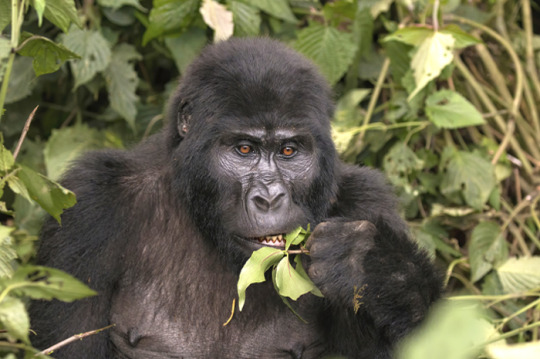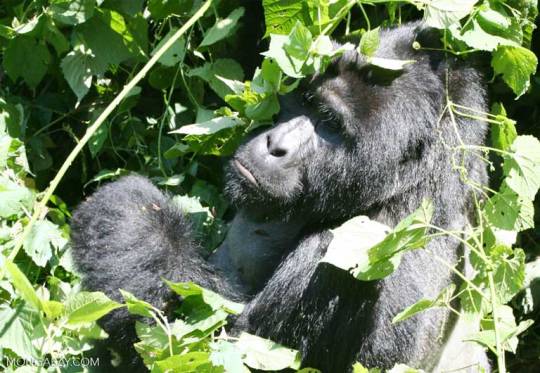#beringei
Text

A mountain gorilla (Gorilla beringei beringei) forages in the Bwindi Impenetrable Forest, Uganda
by Bruno Conjeaud
#eastern gorilla#gorillas#great apes#apes#gorilla beringei#gorilla#hominidae#simiiformes#haplorhini#primates#mammalia#chordata#wildlife: uganda#wildlife: africa
65 notes
·
View notes
Text








#poll#polls on tumblr#random polls#my polls#poll time#tumblr polls#polls#polls are fun#great apes#chimpanzee#gorilla#ape#apes#orangutans#gorillas#primates#orangutan#bonobo#human#Bornean Orangutan#Pongo pygmaeus#Sumatran Orangutan#Pongo abelii#Tapanuli Orangutan#Pongo tapanuliensis#Eastern Gorilla#Gorilla beringei#Western Gorilla#Gorilla gorilla#Chimpanzee
24 notes
·
View notes
Photo

Rarest Animals In The World That Are On The Brink Of Extinction
Mountain Gorilla (Gorilla Beringei Beringei)
Wikimedia Commons
#wikimedia commons#photographer#mountain gorilla#gorilla#ape#animal#mammal#wildlife#gorilla beringei beringei#nature#extinction#endangered
40 notes
·
View notes
Photo









Noisepedia #76: Go-Go Beringei
🎵 | 🎵 | 🎵
🎵 | 🎵 | 🎵
🎵 | 🎵 | 🎵
1 note
·
View note
Text

A silverback mountain gorilla (Gorilla beringei beringei) in the Bwindi Impenetrable National Park, Uganda. 1998.
© James Stejskal
92 notes
·
View notes
Text

Gian Luca Tognon
Baby mountain gorilla
Gorilla beringei
59 notes
·
View notes
Text

Mountain gorilla (Gorilla beringei beringei)
While most gorillas are found in lowland forests, this subspecies is found in the forested mountain regions of the Albertine Rift in central Africa. They have longer fur than other gorillas, allowing them to live in higher, colder altitudes. They eat mostly vegetation, and like other gorillas, they construct leafy nests in which to sleep. They are also very intelligent, and young individuals have been observed dismantling poachers’ traps and snares!
#markhors-menagerie#primates#apes#great apes#animal facts#fun facts#animals#biology#gorilla#mountain gorilla
30 notes
·
View notes
Text
Garten Of Banban: As Above So Below - Primary Genome For Mascots
So uhh, I decided I’d share what animals the Mascots are meant to primarily pull from in my GoBB rewrite, just to give y’all a better idea for what they are gonna be looking and behaving like. So let’s gooo~!
NOTE: ALL SUBJECTS HAVE HOMO SAPIEN (HUMAN) ALONGSIDE THEIR OTHER PRIMARY DNA SOURCE
Banban - Capra Hircus (Domestic Goat)
Banbaleena - Ovis Aries (Domestic Sheep)
Jumbo Josh - Gorilla Beringei Graueri (Eastern Lowland Gorilla)
Captain Fiddles - Brachyteles Hypoxanthus (Woolly Spider Monkey)
Opila Bird - Phoenicopterus Roseus (Greater Flamingo)
Tarta Bird - Pavo Cristatus (Indian Peafowl)
Stinger Flynn - Chrysaora Quinquecirrha (Atlantic Sea Nettle)
Slow Seline - Cornu Aspersum (Garden Snail)
Sheriff Toadster - Bufo Bufo (Common Toad)
Nabnab - Cyriopagopus Lividus (Cobalt Blue Tarantula)
Nabnaleena - Heterometrus Longimanus (Black Scorpion)
Queen Bouncelia - Macropus Giganteus (Eastern Grey Kangaroo)
Bittergiggle - Ectophylla Alba (Honduran White Bat)
Tamataki + Chamataki - Chelonoidis Niger + Trioceros Jacksonii (Galápagos Tortoise + Jackson’s Chameleon)
Syringeon - Dynastes Hercules (Hercules Beetle)
Kittysaurus - Smilodon (Saber-Toothed Tiger)
Zolphius - Biston Betularia (Peppered Moth)
#gobb#garten of banban#garten of banban rewrite#gobb: as above so below#banban#banbaleena#jumbo josh#captain fiddles#opila bird#tarta bird#stinger flynn#slow seline#sheriff toadster#nabnab#nabnaleena#queen bouncelia#bittergiggle#tamataki and chamataki#syringeon#kittysaurus#zolphius
20 notes
·
View notes
Note
hi I’m here to ask about orangutans cause I’m interested
THANK YOU SO MUCH FOR ASKING, sorry it took a bit i was busy but thank you!!
-------------------------------------------------------
So orangutans are primates, primates includes apes(both lesser and greater), monkeys(old world and new world), tarsiers, lorises, and lemurs.
Mostly characterized by larger brain to body ratios, and locomoting using tree to tree hopping, brachiation(branch to branch swinging), bipedalism on their hind legs or quadrapedalism.
Going further through the phylogenetic tree through the sub-orders Haplorhini to the infra-order Simmiiformes we reach the split of old world monkeys(Parv-order: Catarrhini) and new world monkeys(Parv-order: Platyrrhini).
Yet only one is true in its common name, due to apes being lumped into old world monkeys.
Now going to the Superfamily homonoidia we reach apes and only apes.
Apes can be more commonly identified via tailessness.
Homonoidia contains two families Hylobatidae(Lesser Apes) and Hominidae(Great Apes), the main difference between the two is Hylobates not making nests, exhibiting low sexual dimorphism and being smaller on average.
Hylobatidae includes four genera(Hoolock, Hylobates, Nomascus, Symphalangus), but in short lesser apes or the family Hylobatidae only includes gibbons.
Hominidae are great apes(listing closest to farthest genetically from humans) We have humans with only one extant species(Homo Sapians), then chimps and bonobos(Pan Troglodyte and Pan Paniscus respectively), then Gorrilas with 2 extant species(Gorilla Gorilla or Gorilla Beringei), and last but not least with 3 species Orangutans(Pongo Pygmaeus, Pongo abelii, and Pongo Tapanuliensis).
In total orangutans belong to the Domain Eukaryota, Kingdom Animalia, Phylum Chordata, Class Mammalia, Order Primates, Suborder Haplorhini(old world monkeys), Infraorder Simiiformes, Family Hominidae and subfamily Ponginae with 3 species.
The 3 species being Bornean(P. pygmaeus), Sumatran(P. abelii), and the most recently discovered Tapunuli(P. tapunuliensis), with only three subspecies belonging to the Bornean orangutans(Pygmaeus, Morio and wurmbii)
The adult males grow cheek pads(flanges) that can act as dishes to further their calls due to being more solitary in nature, and depending on the species can also be different in shape. Still reasearchers are completely unsure on why some adult males grow them and why some dont.
Even though their general omnivorous nature theyre more frugivourus which could be one of the factors for their more solitary nature. Due to their omnivory they also eat bark, insects, bird eggs, honey, and smaller primates such as bush babies.
Like gorillas, each night orangutans make makeshift nests out of leaves for them and, in the case of mothers, their childrens. Social bonds are almost primarily females and their offspring which will often, even in adulthood, will come back and visit.
Adult females usually stand about 3'9 and weigh about 37 kg(82lbs), while adult males reach up to 4'6 and weigh 75kg(165 lbs). Orangutans having longer arms and shorter arms for arboreal life and easier brachiating(the action of swinging from branch to branch), with the average arm span of 6.6ft. The heaviest orangutan to live is a male bornean orangutan, "Andy", who weighed up to 204kg(450lbs) at 13 years old.
With smaller thumbs, longer fingers, and resting configuration of a suspendery hooks, orangutans have an easier time hanging with the advantage double locked grip by resting the tips of the fingers against their palms, same for their feet. Hip joints similar to their shoulders allow for similar ranges of motion. Unlike their great ape cousins though, orangutans arent true knuckle walkers, prefering to walk on their fist and the sides of their feet.
3 notes
·
View notes
Text
Let’s save the wildlife – Eastern lowland gorilla (Gorilla beringei graueri) – Myrela
Eastern lowland gorillas, also known as Grauer’s gorillas, are found only in the Democratic Republic of Congo (DRC) and are critically endangered, threatened by increased contact with humans. Of the four sub-species of gorilla, all of which live in equatorial Africa, the eastern lowland gorilla is the largest. It’s estimated that there are just 6,800 individuals living in DRC’s Kahuzi-Biega and…

View On WordPress
3 notes
·
View notes
Text


Mountain Gorilla in Bwindi Impenetrable Forest, Uganda
Leila Boujnane
Population: 1,063
Mass: males can weigh 430 pounds
Daily sleep: about 12 hours
Scientific name: Gorilla beringei beringei
As their name implies, mountain gorillas live in forests high in the mountains, at elevations of 8,000 to 13,000 feet. They have thicker fur, and more of it, compared to other great apes. The fur helps them to survive in a habitat where temperatures often drop below freezing.
They can eat all day long. Mountain gorillas spend about a quarter of their day eating, mainly plants. Around 85% of their diet is made up of leaves, shoots and stems, but gorillas can also eat larvae, snails, ants, and even roots, barks and rotting wood (a good source of sodium/salt).
The only significant natural predator of the mountain gorilla is the leopard. The main threat that mountain gorillas face is from humans. Humans hunt gorillas for meat, just as a natural predator would.
Humans are pushing mountain gorillas out of the wild and into extinction. The biggest threats to this once critically endangered great ape's survival come from political instability, human encroachment, and forest degradation.
3 notes
·
View notes
Text

A mountain gorilla (Gorilla beringei beringei) in Virunga Volcanoes, Rwanda
by Gary Faulkner
#mountain gorilla#eastern gorilla#gorillas#great apes#apes#gorilla beringei beringei#gorilla beringei#gorilla#hominidae#simiiformes#primates#mammalia#chordata#wildlife: rwanda#wildlife: africa
91 notes
·
View notes
Text
"Grauer's Gorilla"
2021

Grauer's Gorilla (Gorilla beringei graueri)
#grauers gorilla#eastern gorilla#gorilla#primates#apes#animals#animal art#wildlife art#wildlife#photoshop#art#artists on tumblr#mexican artist#autistic artist#dartxo
5 notes
·
View notes
Photo

Research indicates that endangered mountain gorillas (Gorilla beringei) in Uganda’s Bwindi Impenetrable National Park are being exposed to pesticides via the cultivation of tea and the consumption of contaminated plant leaves. This could have “potential health risks” for adults and juveniles, the study concluded, though the full extent of harm is still unknown.
Image by Rhett A. Butler / Mongabay.
#rhett a butler#photographer#mongabay#mountain gorilla#gorilla#ape#gorilla beringei#uganda#bwindi impenetrable national park#nature#animal#mammal#wildlife
10 notes
·
View notes
Photo



neo twewy au
i’ve been thinking for a long time about what animal noise form!aiger would be and ended up going with a wolf. an obvious answer would be a gorilla, but i took a look at the go-go beringei boss for some direction and went hmm... no. plus aiger has that whole lone wolf thing going, and when i see ‘wild animal’ my first thought is a wolf.
aiger has very little control of himself when he’s in this form, and since ranjiro is the only one he listens to, ranjiro often gets hurt trying to calm him down again. idk if aiger’s noise form would also be as big as other bosses, or maybe he can change his size for maximum destruction :\
26 notes
·
View notes
